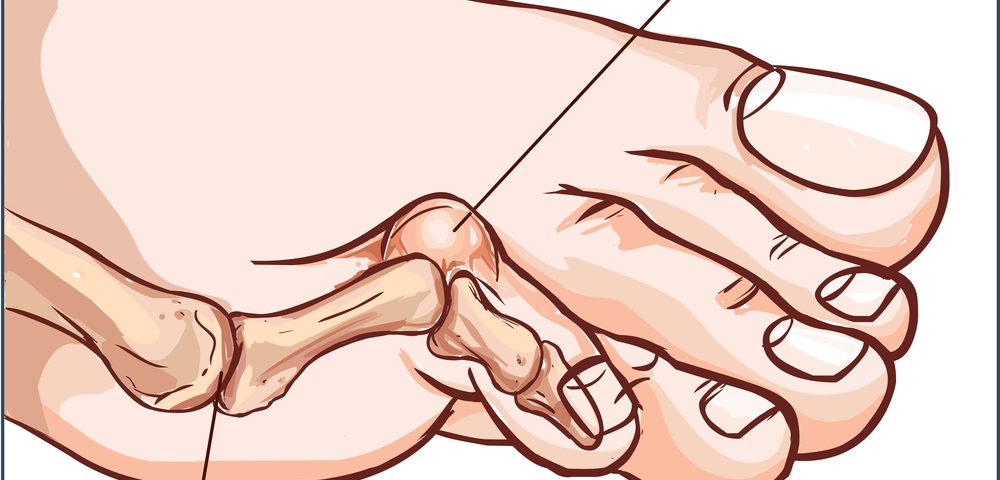Hammer toes are a common foot problem that can cause pain and reduce a person's overall quality of life. This disorder, also known as contracted toes, is distinguished by an unnatural bending of the toes in the shape of a hammer. In this article, we will delve into the causes, symptoms, diagnosis, and treatment options for hammer toes, as well as offer tips for prevention.
Causes
Hammer toes often develop over time as a result of a number of different factors. Wearing shoes that are extremely tight or thin, pushing the toes into unusual positions is a typical cause. High-heeled shoes, which place excessive pressure on the toes and restrict their mobility, can also contribute to the development of hammer toes. Other causes of hammer toes include genetic susceptibility, arthritis, toe damage, and muscle imbalance.
Symptoms
The most apparent sign of hammer toes is inappropriate bending of one or more toes, usually at the middle joint. Toes affected by this condition may seem twisted, crooked, or constricted, like a hammer or a claw. This can be irritating and painful, especially while wearing shoes or walking. The friction and pressure from the bent toes rubbing against shoes can also cause corns and calluses to form on the top of the ball of the foot.
Diagnosis
If you think that you have hammer toes, you should see a podiatrist as soon as possible to get a proper diagnosis. The doctor will check the look of your toes as well as your foot structure and flexibility during a physical examination. They may also request X-rays to establish the amount of the deformity and rule out other underlying medical conditions like arthritis.
Treatment
Treatment options for hammer toes are determined by the severity of the problem and the amount of discomfort noticed. Conservative approaches can help ease symptoms and prevent further damage if the condition is mild. These might include:
Modifications to footwear
Wearing shoes with a wider toe box and a lower heel might give more space for the toes as well as relieve pressure and pain. Custom-made shoe inserts or orthotic inserts may also improve foot alignment and reduce discomfort.
Toe exercises and stretches
Certain exercises can help strengthen and stretch the toe muscles. These exercises may include picking up tiny things with your toes or gently stretching and straightening the affected toes with your hands.
Padding and splinting
Applying padding or cushions to the affected areas may reduce pressure and prevent the formation of corns and calluses. Splinting the toes can also help straighten them and alleviate pain.
Medications
Acetaminophen and nonsteroidal anti-inflammatory drugs (NSAIDs) are common over-the-counter painkillers that can be used to treat hammer toe pain and inflammation. However, before taking any medication, you should contact a healthcare professional.
Surgery
When conservative treatment options fail to provide relief or the deformity has a major impact on the person's mobility and quality of life, surgical treatment may be recommended to deal with such severe situations. The surgical procedure used will be determined by the extent and type of deformity present.
Prevention
Despite the fact that not all cases of hammer toes are preventable, there are steps you may take to lower the likelihood of developing them:
- Wear shoes that fit correctly: Choose shoes that allow your toes to move and bend freely. High heels and shoes with a tiny toe box that might squeeze the toes together should be avoided.
- Choose supportive footwear: Look for shoes with strong arch support and cushioning that help distribute weight evenly across the foot and prevent stress on the toes.
- Perform regular toe exercises: Simple exercises like toe stretches and toe curls can help maintain the toe muscles strong and flexible.
- Maintain a healthy weight: Excess weight puts extra strain on the feet and toes, increasing the risk of hammer toes.
The bottom line
Hammer toes are a common foot problem defined by unusual toe bending. Although they may be uncomfortable and interfere with everyday activities, there are a number of treatment options, from conservative approaches to surgical procedures.
People may actively maintain foot health and prevent the development of this problem by being aware of the causes, symptoms, and treatment options related to hammer toes. It's crucial to get medical attention from a healthcare provider in order to receive an accurate diagnosis and a customized treatment plan if you think you might have hammer toes or suffer from foot pain.






Comments